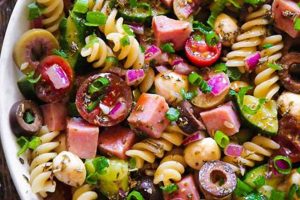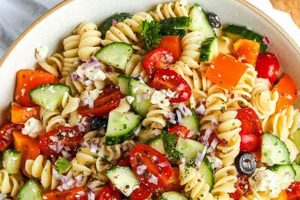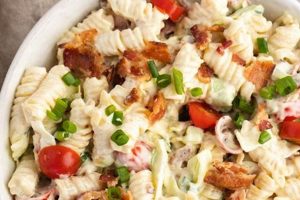This dish combines the classic elements of a Caesar salad romaine lettuce, Parmesan cheese, croutons, and a creamy dressing with the addition of pasta. Variations can include grilled chicken, shrimp, or other proteins, and different pasta shapes may be used. A simple example includes cooked pasta tossed with chopped romaine, homemade croutons, grated Parmesan, and a Caesar dressing, potentially enhanced with anchovy paste or lemon juice.
Adding pasta transforms a light salad into a more substantial and satisfying meal. This adaptation offers a convenient way to incorporate vegetables and lean protein into a diet. The flexibility of the dish allows for customization based on dietary preferences and available ingredients. Historically, the Caesar salad originated in Tijuana, Mexico, and its evolution to include pasta showcases the adaptability of culinary traditions.
The following sections will explore optimal pasta choices, dressing variations from classic to modern interpretations, techniques for preparing homemade croutons, and suggestions for additional ingredients to enhance the dish further.
Tips for an Exceptional Pasta Caesar Salad
Creating a truly delicious pasta Caesar salad involves attention to detail and a few key techniques. These tips offer guidance on elevating this dish from simple to extraordinary.
Tip 1: Pasta Selection: Choose pasta shapes that hold the dressing well, such as rotini, fusilli, or farfalle. Avoid long, thin pasta like spaghetti, which can become tangled and difficult to coat evenly.
Tip 2: Dressing Consistency: The dressing should be creamy and emulsified, not overly thin. A thicker dressing adheres better to both the pasta and romaine lettuce.
Tip 3: Crouton Texture: Homemade croutons offer superior flavor and texture. Ensure they are crisp and golden brown, not overly dry or burnt.
Tip 4: Romaine Preparation: Use crisp, cold romaine lettuce. Tear the leaves into bite-sized pieces rather than chopping them, which can cause bruising.
Tip 5: Parmesan Quality: Freshly grated Parmesan cheese offers a significantly better flavor than pre-grated varieties. Grate the cheese finely for optimal distribution throughout the salad.
Tip 6: Ingredient Balance: Ensure a balance of flavors and textures. The saltiness of the Parmesan, the richness of the dressing, the crispness of the croutons, and the freshness of the romaine should complement one another.
Tip 7: Protein Addition (Optional): Grilled chicken, shrimp, or salmon can be added for extra protein. Ensure the protein is cooked thoroughly and seasoned appropriately.
By following these tips, one can achieve a pasta Caesar salad with balanced flavors, appealing textures, and a satisfying overall experience.
These insights offer a comprehensive guide to creating a pasta Caesar salad that is both delicious and visually appealing. The following section provides a complete recipe for practical application of these techniques.
1. Pasta Choice
Pasta choice significantly impacts the overall success of a Caesar salad with pasta. The ideal pasta complements the other ingredients, holding the dressing effectively and contributing to a balanced texture. Short, sturdy shapes like rotini, fusilli, and farfalle work well because their ridges and curves capture the creamy dressing and prevent it from pooling at the bottom of the bowl. Penne, with its hollow center, also proves suitable. Conversely, long, thin pasta like spaghetti or linguine tends to clump together and becomes difficult to coat evenly, resulting in a less satisfying eating experience. Overly small pasta shapes, such as orzo, while capable of holding dressing, can feel overwhelming in proportion to the other ingredients and lack the desired textural contrast.
Consider the practical implications of pasta selection. A well-chosen pasta enhances the dish’s visual appeal and contributes to the ease of serving and eating. For instance, rotini’s spiral shape not only captures the dressing but also provides a pleasant visual contrast against the crisp romaine lettuce and creates convenient bite-sized portions. Conversely, long strands of spaghetti can become unwieldy and detract from the overall presentation. The choice of pasta directly influences how well the flavors and textures of the dish meld together. For example, the robust texture of penne provides a satisfying counterpoint to the creamy dressing and crisp croutons, while the delicate nature of orzo may become lost amidst the other components.
Appropriate pasta selection is crucial for achieving a harmonious balance of flavors, textures, and presentation in a Caesar salad with pasta. The shape and size of the pasta should complement the other ingredients, ensuring the dressing adheres properly and the dish offers both visual appeal and ease of consumption. Selecting pasta strategically enhances the overall dining experience, demonstrating an understanding of the interplay between ingredients and the importance of considering practical implications alongside flavor profiles.
2. Dressing Emulsification
Dressing emulsification plays a crucial role in the overall quality of a Caesar salad with pasta. A properly emulsified dressing provides a smooth, creamy texture and ensures the flavors are evenly distributed throughout the dish. Emulsification prevents the dressing from separating into its oil and water components, which can lead to a greasy, unappetizing salad. This process directly impacts the sensory experience of the dish, affecting both flavor perception and mouthfeel.
- Stability and Coating Ability
A stable emulsion prevents the dressing from separating and ensures it adheres effectively to the pasta and other ingredients. This uniform coating enhances flavor distribution and prevents the salad from becoming watery or oily. For instance, a broken emulsion may result in the oil pooling at the bottom of the bowl, while a stable emulsion keeps the dressing evenly dispersed throughout the salad. In a pasta Caesar salad, this stability is particularly important because the pasta’s surface area absorbs the dressing, requiring a more robust emulsion to maintain its integrity.
- Flavor Enhancement and Delivery
Emulsification contributes to flavor enhancement by evenly dispersing ingredients like garlic, anchovies, and lemon juice throughout the dressing. This ensures a consistent flavor profile in every bite. The emulsified fat carries flavor compounds, allowing them to coat the palate more effectively. In a pasta Caesar salad, the emulsified dressing clings to the pasta, delivering a balanced flavor experience with each mouthful. A broken emulsion, conversely, would result in uneven flavor distribution, with some bites tasting overwhelmingly of oil and others lacking the characteristic Caesar flavor.
- Texture and Mouthfeel
Emulsification affects the texture and mouthfeel of the dressing, creating a smooth, creamy consistency that contrasts pleasantly with the crisp romaine and croutons. A well-emulsified dressing coats the palate evenly, enhancing the perception of richness and flavor. Conversely, a separated dressing can feel oily and heavy on the palate, detracting from the overall dining experience. In a pasta Caesar salad, the creamy dressing enhances the pasta’s textural appeal, while a broken emulsion could result in a greasy, less enjoyable meal.
- Visual Appeal
A properly emulsified dressing offers a glossy, appealing appearance that enhances the visual presentation of the salad. The smooth, creamy texture reflects light, creating a visually appealing dish. Conversely, a separated dressing can look unappetizing and suggest a lack of freshness. In a pasta Caesar salad, the emulsified dressing enhances the vibrancy of the other ingredients, contributing to a more appealing presentation. A separated dressing, however, could make the salad look oily and less desirable.
Effective dressing emulsification is thus integral to a successful Caesar salad with pasta. It impacts not only the flavor and texture but also the visual appeal and overall enjoyment of the dish. The stability, flavor delivery, textural enhancement, and visual appeal provided by a well-emulsified dressing contribute significantly to the harmonious blend of ingredients that define a high-quality pasta Caesar salad. Understanding the role of emulsification provides a deeper appreciation for the complexities of this seemingly simple dish.
3. Crouton Crispness
Crouton crispness constitutes a critical textural element within a Caesar salad with pasta recipe. The contrast between the crisp croutons and the other, softer componentsthe creamy dressing, the tender pasta, and the leafy romainecreates a dynamic sensory experience. This textural interplay elevates the dish beyond a simple combination of ingredients, adding a layer of complexity that enhances enjoyment. Consider the difference between biting into a crisp crouton and a soggy one: the former offers a satisfying crunch that complements the other textures, while the latter contributes a damp, unpleasant sensation that detracts from the overall experience. This textural contrast directly impacts palatability and underscores the significance of achieving optimal crouton crispness.
The practical implications of crouton texture extend beyond mere sensory enjoyment. Soggy croutons indicate moisture absorption, which can negatively affect the overall structural integrity of the salad. As croutons absorb moisture from the dressing and other ingredients, they lose their crispness and become heavy, contributing to a less appealing, potentially mushy final product. Furthermore, the absorption of dressing by the croutons can diminish the flavor distribution within the salad as a whole. Maintaining crouton crispness therefore not only contributes to a more enjoyable textural experience but also safeguards against undesirable moisture imbalances that can compromise the dish’s overall quality. For instance, freshly made, properly stored croutons can maintain their crispness for a longer period, contributing to a more satisfying salad even when prepared in advance.
Achieving and maintaining crouton crispness requires attention to preparation and storage techniques. Properly sized and evenly toasted croutons ensure consistent texture throughout the salad. Storing croutons separately from the dressed salad components prevents premature moisture absorption, preserving their crispness until the point of consumption. Understanding the impact of crouton crispness on both the immediate sensory experience and the overall quality of the pasta Caesar salad emphasizes its importance as a crucial element of the recipe. The practical steps taken to achieve and maintain this crispness directly influence the success of the dish, demonstrating a clear connection between technique and outcome.
4. Romaine Freshness
Romaine lettuce freshness significantly impacts the overall quality of a Caesar salad with pasta. Fresh romaine provides crisp texture and a subtly sweet, slightly bitter flavor that complements the richness of the dressing and the saltiness of the Parmesan. A crisp, vibrant romaine offers a refreshing counterpoint to the other ingredients, contributing to a balanced and enjoyable sensory experience. Conversely, wilted or browned romaine detracts from both the flavor and the visual appeal of the dish, resulting in a less satisfying meal. Consider the difference between a salad made with crisp, cold romaine and one made with limp, aging lettuce: the former offers a refreshing crunch and vibrant green color, while the latter presents a less appealing, potentially off-putting texture and appearance. This contrast underscores the importance of romaine freshness in achieving a successful Caesar salad with pasta.
The practical implications of using fresh romaine extend beyond mere aesthetics and flavor. Fresh romaine holds its shape better when tossed with the dressing and other ingredients, maintaining the structural integrity of the salad. Wilted romaine, on the other hand, tends to become soggy and lose its structure, leading to a less appealing, potentially watery final product. Furthermore, the shelf life of the salad is directly influenced by the freshness of the romaine. A salad made with fresh romaine will maintain its quality for a longer period compared to one made with older lettuce. This practical consideration is particularly important for meal prepping or when serving the salad to a larger group. For instance, if preparing the salad in advance, using fresh, crisp romaine ensures it will still be enjoyable hours later, while using less-than-fresh romaine may result in a wilted, unappetizing salad by the time it is served.
Selecting and storing romaine lettuce correctly is crucial for preserving its freshness and optimizing its contribution to the pasta Caesar salad. Choosing romaine hearts with crisp, unblemished leaves is the first step. Proper storage, such as wrapping the lettuce in a damp paper towel and placing it in a sealed container in the refrigerator, helps maintain its freshness for an extended period. Understanding the impact of romaine freshness on the overall quality, texture, and shelf life of the pasta Caesar salad highlights its essential role in achieving a successful dish. The practical steps taken to select and preserve romaine’s freshness directly translate to a more enjoyable and aesthetically pleasing culinary experience, emphasizing the connection between ingredient quality and the final outcome.
5. Parmesan Quality
Parmesan quality significantly influences the overall flavor profile of a Caesar salad with pasta. Authentic Parmigiano-Reggiano, with its complex, nutty, and slightly salty flavor, elevates the dish, adding a depth that generic “Parmesan” cheeses often lack. The granular texture of high-quality Parmesan contributes a pleasant mouthfeel and melts subtly when combined with the other ingredients. Conversely, using a lower-quality substitute can result in a bland, almost plastic-like flavor and a gritty texture that detracts from the overall dining experience. Consider the difference between the sharp, savory bite of true Parmigiano-Reggiano and the dull, sometimes bitter taste of an inferior imitation: the former enhances the other flavors, while the latter can introduce undesirable notes that clash with the delicate balance of the salad. This distinction underscores the importance of Parmesan quality in achieving an authentic and flavorful Caesar salad with pasta.
The impact of Parmesan quality extends beyond immediate flavor perception. Genuine Parmigiano-Reggiano possesses a unique aging process that contributes to its complex flavor profile and granular texture. This aging process also affects how the cheese interacts with other ingredients. High-quality Parmesan melts more readily and evenly, distributing its flavor throughout the salad. Lower-quality cheeses, often made with fillers and artificial ingredients, may not melt properly, resulting in an uneven distribution of flavor and a less desirable texture. For instance, grating fresh Parmigiano-Reggiano over the salad just before serving allows its full flavor to shine, while pre-grated, lower-quality Parmesan may have a diminished flavor and a drier, less appealing texture. This difference illustrates the practical implications of Parmesan quality in achieving the desired culinary outcome.
Selecting and utilizing high-quality Parmesan cheese is essential for achieving an authentic and flavorful Caesar salad with pasta. The unique flavor profile, granular texture, and melting properties of true Parmigiano-Reggiano contribute significantly to the overall sensory experience and balance of the dish. Investing in high-quality Parmesan elevates the salad from a simple combination of ingredients to a more refined and satisfying culinary creation. Recognizing the impact of Parmesan quality on both the immediate taste and the overall composition of the salad underscores its importance as a key ingredient. Selecting authentic Parmigiano-Reggiano demonstrates an understanding of the nuanced interplay of flavors and textures that define a truly exceptional Caesar salad with pasta.
6. Ingredient Balance
Ingredient balance constitutes a crucial factor in a successful Caesar salad with pasta recipe. This balance refers to the harmonious interplay of flavors and textures among the various components: the creamy dressing, the crisp romaine lettuce, the crunchy croutons, the salty Parmesan cheese, and any additional ingredients, such as grilled chicken or shrimp. A well-balanced salad features a proportionate distribution of these elements, ensuring that no single flavor or texture dominates the others. An excess of dressing, for example, can overwhelm the delicate flavors of the romaine and Parmesan, while insufficient croutons may diminish the desired textural contrast. Consider a salad with an overabundance of Parmesan: the intense saltiness can overshadow the other flavors, creating a less nuanced and ultimately less satisfying experience. Conversely, a salad lacking acidity from the dressing may taste bland and uninspired. This interplay of flavors and textures underscores the importance of ingredient balance in achieving a harmonious and enjoyable culinary outcome.
The practical significance of ingredient balance extends beyond mere flavor and texture considerations. Proper balance ensures that the salad offers nutritional diversity and avoids becoming overly rich or heavy. For instance, a salad with a large portion of grilled chicken provides substantial protein, while a lighter version with minimal additions caters to those seeking a less calorically dense meal. Furthermore, ingredient balance contributes to the overall structural integrity of the salad. A well-balanced salad maintains its form, with the dressing coating the ingredients evenly without causing them to become soggy or wilted. An improperly balanced salad, on the other hand, may become watery or overly dense, diminishing its appeal and practicality. For example, a salad with too much dressing can make the romaine lettuce wilt and the croutons lose their crispness, detracting from the overall texture and presentation. This interconnectedness between ingredient balance and the overall quality of the salad highlights the practical implications of achieving a harmonious composition.
Achieving ingredient balance in a Caesar salad with pasta recipe requires careful consideration of proportions and flavor profiles. Understanding the individual contributions of each ingredientthe richness of the dressing, the bitterness of the romaine, the saltiness of the Parmesan, the crunch of the croutons, and the savory notes of any added proteinallows for informed adjustments to achieve the desired balance. This understanding translates to a more nuanced and enjoyable culinary experience, demonstrating the direct connection between ingredient balance and the overall success of the dish. Mastering this balance elevates the Caesar salad with pasta from a simple combination of ingredients to a carefully orchestrated symphony of flavors and textures, showcasing the culinary artistry of proportion and balance.
7. Protein Options
Protein options represent a significant point of customization within the Caesar salad with pasta recipe framework. Incorporating protein transforms the dish from a side salad or a light meal into a more substantial and nutritionally complete main course. The choice of protein influences not only the nutritional value but also the overall flavor profile and textural complexity of the salad. Understanding the various protein options and their respective contributions allows for informed decisions tailored to individual dietary needs and preferences.
- Poultry
Chicken, particularly grilled or roasted, remains a classic pairing with Caesar salad. Its mild flavor complements the dressing and other ingredients without overpowering them. Sliced or diced chicken breast offers a lean protein source, while darker meat options like thighs provide a richer flavor and more tender texture. Consider the difference between grilled chicken with its smoky char and roasted chicken with its succulent, juicy interior: each preparation method imparts distinct nuances that can enhance the overall salad experience.
- Seafood
Shrimp, grilled or pan-seared, offers a lighter, brinier alternative to poultry. Its delicate flavor complements the richness of the Caesar dressing while adding a textural dimension distinct from chicken. Other seafood options, such as flaked salmon or grilled tuna, introduce different flavor profiles and nutritional benefits, including omega-3 fatty acids. Imagine the contrast between the sweet, succulent flavor of grilled shrimp and the robust, meaty texture of seared tuna: each seafood choice offers a unique culinary experience within the Caesar salad framework.
- Vegetarian/Vegan Options
For those adhering to vegetarian or vegan diets, protein options extend beyond animal-based choices. Chickpeas, roasted or pan-fried until crispy, offer a plant-based protein source with a satisfying texture. Tofu, prepared similarly, can also provide a substantial protein component. Furthermore, incorporating ingredients like avocado or edamame contributes healthy fats and plant-based protein, enhancing both the nutritional value and the textural complexity of the salad. Consider the contrast between the nutty flavor and firm texture of roasted chickpeas and the creamy richness of avocado: these plant-based options offer diverse flavor and texture profiles that complement the traditional Caesar salad components.
- Cured Meats
Adding cured meats like prosciutto or pancetta introduces a salty, savory dimension to the Caesar salad with pasta. The crisp texture of these meats contrasts with the creamy dressing and soft pasta, enhancing the overall sensory experience. However, the strong flavors of cured meats require careful balancing to avoid overpowering the other ingredients. Imagine the interplay between the salty, smoky flavor of crisp pancetta and the creamy, tangy Caesar dressing: this combination offers a complex flavor profile that adds depth to the traditional salad.
The selected protein option fundamentally alters the character of the Caesar salad with pasta. From the lean simplicity of grilled chicken to the rich complexity of cured meats, each protein choice contributes a distinct set of flavors, textures, and nutritional benefits. Consideration of these factors allows for customized variations that cater to individual dietary preferences and desired flavor profiles, ultimately transforming a classic salad into a versatile and adaptable main course.
Frequently Asked Questions
This section addresses common inquiries regarding Caesar salad with pasta, providing clear and concise information to ensure optimal preparation and enjoyment.
Question 1: What type of pasta works best in a Caesar salad?
Short, sturdy pasta shapes like rotini, fusilli, or penne are recommended. These shapes hold the dressing well and provide textural contrast. Long, thin pasta like spaghetti is less suitable as it tends to clump and is difficult to coat evenly.
Question 2: Can Caesar dressing be made from scratch?
Homemade Caesar dressing is achievable and often preferred for its fresh flavor. Traditional recipes involve raw egg yolks, but variations using mayonnaise or coddled egg yolks offer safer alternatives. Numerous online resources provide detailed instructions.
Question 3: How can croutons be made at home?
Homemade croutons offer superior flavor and texture. Cubed bread can be tossed with olive oil, herbs, and seasonings, then baked or pan-fried until golden brown and crispy. Adjusting cooking time and temperature prevents burning and ensures desired crispness.
Question 4: What are suitable protein additions?
Grilled chicken, shrimp, or salmon are popular protein additions. Vegetarian options include chickpeas, tofu, or avocado. The protein should complement the other flavors without overpowering the salad.
Question 5: How should the salad be stored?
Storing ingredients separatelydressing, croutons, and the combined pasta and romaineis recommended. Combining all components just before serving maintains optimal texture and prevents the salad from becoming soggy.
Question 6: Can anchovies be omitted from the dressing?
Anchovies contribute a distinctive umami flavor to traditional Caesar dressing. While their omission alters the classic taste, palatable dressings can be created without them. Alternatives include Worcestershire sauce or additional Parmesan cheese for a savory depth.
Careful consideration of these points ensures a successful and enjoyable Caesar salad with pasta experience. Addressing these common concerns helps optimize ingredient selection, preparation methods, and storage techniques, resulting in a dish that balances flavor, texture, and visual appeal.
The following section offers a complete recipe, incorporating the insights and tips provided throughout this article.
Caesar Salad with Pasta Recipe
Exploration of this dish reveals the careful orchestration required to achieve a successful outcome. Significant attention must be devoted to ingredient selection, from the pasta shape to the Parmesan quality. Proper dressing emulsification, crouton crispness, and romaine freshness contribute significantly to the final product. Ingredient balance ensures a harmonious interplay of flavors and textures, while protein choices offer opportunities for customization and nutritional enhancement. Understanding these elements allows for a deeper appreciation of this seemingly simple dish’s complexity.
This adaptable recipe provides a foundation for culinary creativity. Strategic ingredient choices and thoughtful preparation techniques elevate this dish beyond a mere combination of components, transforming it into a satisfying and versatile culinary experience. Further exploration of flavor profiles and ingredient combinations offers continued opportunities for personalized interpretations and innovative adaptations.






